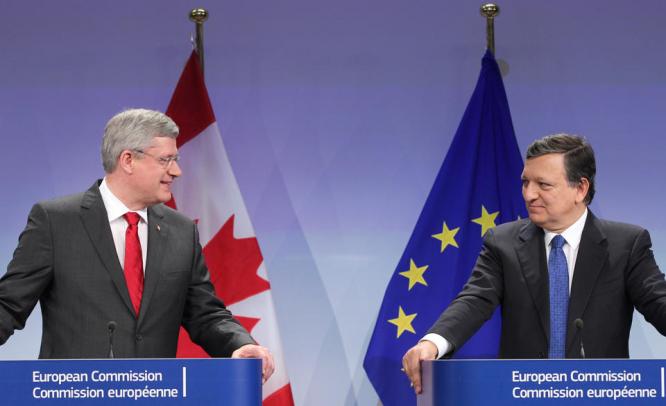The deal will make Canada the only G8 country to have preferential access to the world’s two largest markets, the EU and the United States.
24th October 2013
The European Union and Canada agreed on a multibillion – trade pact on Friday that will integrate two of the world’s largest economies and paves the way for Europe to clinch an even bigger deal with the United States.
European Commission President Jose Manuel Barroso and Canadian Prime Minister Stephen Harper reached a political agreement on the key elements of the free trade agreement, known as Comprehensive Economic and Free Trade Agreement (CETA).
The deal will make Canada the only G8 country to have preferential access to the world’s two largest markets, the EU and the United States. Canadian Prime Minister Stephen Harper hailed it as “the biggest trade deal our country has ever made” while European Commission head Jose Manuel Barroso said it was “ highly ambitious and far reaching and of great importance for the EU economy”. “It will provide new opportunities by increasing market access and be the basis for gaining a strong foothold in the North American market and act as a catalyst for growth in Europe,” he said.
According to the EU, the agreement is expected to increase bilateral trade in goods and services by 23 percent, or 26 billion Euros ($ 35 billion), it is estimated that the benefits of the agreement are expected to raise the level of EU’s annual GDP by 12 billion Euros a year.
Negotiations Conclude
Talks between the two sides started in May 2009 but stalled for months over quotas for Canadian beef and EU cheese. The negotiations emerged successful after Harper and European Commission President Jose Manuel Barroso met in Brussels to resolve outstanding issues and sealed the deal.
Historic Breakthrough
The successful negotiations between Harper and Barros meant the accord would surpass the North American Free Trade Agreement (NAFTA) signed between U.S., Mexico and Canada. The deal marks a breakthrough for Brussels’ free trade agenda, which had previously achieved smaller agreements with South Korea and Singapore. It is expected to increase bilateral trade in goods and services to 25.7 billion Euros a year, according to the latest EU estimates. A key sticking point was Ottowa’s request for increased access for its beef while the EU wanted to cut tariffs of up to 300 percent shielding Canada’s dairy industry from imports of European cheese. On dairy, the province’s government said Ottawa had committed to compensate producers for any losses due to the new import quotas. Reflecting such difficulties, the agreement signed- is one in principle, not a final document. Barroso hoped that the agreement would fall in place after EU governments, EU parliament and Canada’s 10 provinces give their approval.
The commission is negotiating trade pacts with more than 80 countries on behalf of the bloc’s 28 members after the collapse of the marathon Doha round of global trade talks. The delays that prevented from signing the agreement with Canada, with many countries and provinces opposing certain trade measures which could hurt their economy shows how difficult such deals can be. Efforts by European leaders to sign a trade pact with the U.S. suffered a setback as the second round of negotiations was cancelled because of the U.S. government shutdown, the talks have also been overshadowed by reports that the U.S. bugged EU offices under surveillance programmes – made public by former NASA contractor and whistleblower Edward Snowden – who has now taken refuge in Russia.
However, the EU-Canada agreement could provide a major impetus for EU-U.S negotiations. Both deals seek to go far beyond tariff cuts and reduce transatlantic barriers to business.


